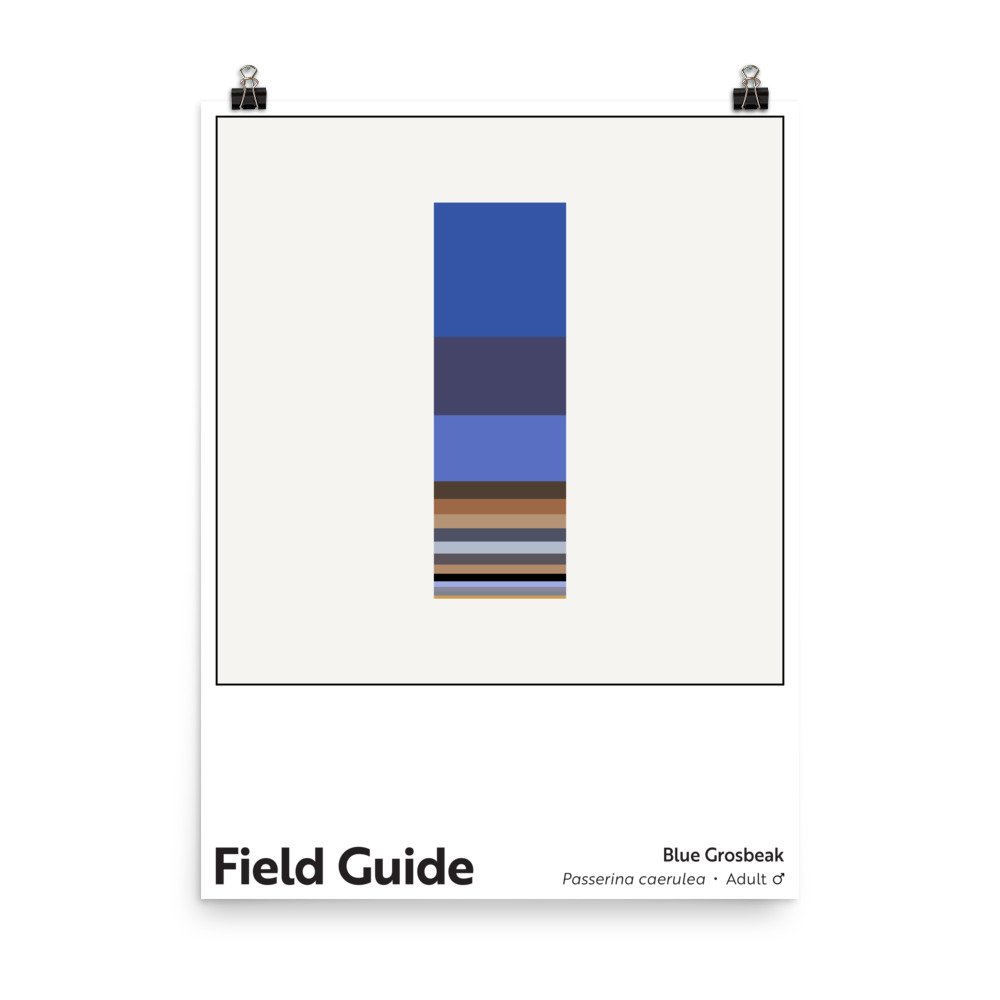 Image 1 of 2
Image 1 of 2

 Image 2 of 2
Image 2 of 2



Field Guide : Blue Grosbeak (Male)
Unlimited edition. 18 x 24 inch, museum-quality poster on matte paper.
Looking at a blue grosbeak, you probably wouldn’t recognize it as a relative of the Northern cardinal. The rich sapphire* and cinnamon of the male blue grosbeak don’t exactly call the bold reds, oranges, and blacks of the male cardinal to mind, but they’re both members of the cardinal family. (*Some people describe the blue grosbeak’s color as “blurple,” but that portmanteau sounds like an infection or digestive issue to me.)
Despite their punchy color, blue grosbeaks are usually hard to spot, a result of their preference for shrubby habitats. My last blue grosbeak sighting was in the foothill grasslands west of Fort Collins, Colorado. A male briefly perched atop some vegetation to announce his presence, then dropped back down out of sight moments after I’d trained my binoculars on him.
There are six or seven recognized blue grosbeak subspecies; these different populations exhibit subtle color variation. This poster doesn’t specify which subspecies I looked at to create the color column because 1) the morphological differences between the subspecies are minor and 2) I looked closely at two of the subspecies, Passerina caerulea caerulea and P. c. interfusa, both of which occur across much of the United States.
Note: These archival poster prints feature rich, appealing colors. I encourage customers to take care in handling them until they are framed/protected for display; the darker colors on the matte paper can be scratched. They ship rolled, so customers need to flatten them before framing (or have their framer do so).
Charitable Sales Model: Whenever one of these poster prints is purchased, a charitable contribution equal to 10% of the print’s cost (or $3.60) is made to a nonprofit working to tackle environmental or social challenges. Read more about my charitable sales model here.
Unlimited edition. 18 x 24 inch, museum-quality poster on matte paper.
Looking at a blue grosbeak, you probably wouldn’t recognize it as a relative of the Northern cardinal. The rich sapphire* and cinnamon of the male blue grosbeak don’t exactly call the bold reds, oranges, and blacks of the male cardinal to mind, but they’re both members of the cardinal family. (*Some people describe the blue grosbeak’s color as “blurple,” but that portmanteau sounds like an infection or digestive issue to me.)
Despite their punchy color, blue grosbeaks are usually hard to spot, a result of their preference for shrubby habitats. My last blue grosbeak sighting was in the foothill grasslands west of Fort Collins, Colorado. A male briefly perched atop some vegetation to announce his presence, then dropped back down out of sight moments after I’d trained my binoculars on him.
There are six or seven recognized blue grosbeak subspecies; these different populations exhibit subtle color variation. This poster doesn’t specify which subspecies I looked at to create the color column because 1) the morphological differences between the subspecies are minor and 2) I looked closely at two of the subspecies, Passerina caerulea caerulea and P. c. interfusa, both of which occur across much of the United States.
Note: These archival poster prints feature rich, appealing colors. I encourage customers to take care in handling them until they are framed/protected for display; the darker colors on the matte paper can be scratched. They ship rolled, so customers need to flatten them before framing (or have their framer do so).
Charitable Sales Model: Whenever one of these poster prints is purchased, a charitable contribution equal to 10% of the print’s cost (or $3.60) is made to a nonprofit working to tackle environmental or social challenges. Read more about my charitable sales model here.